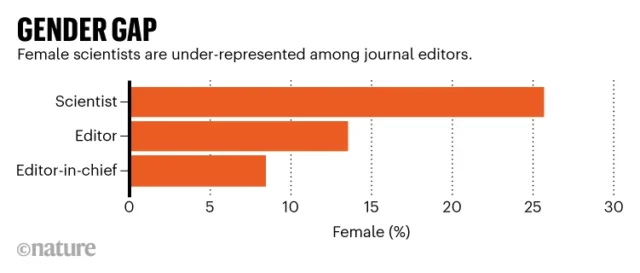From Nature:
The gender gap among senior journal editors is bigger than many people thought, and some editors publish a surprising number of their own papers in the journals that they edit, finds the first study to look at these issues over time across multiple disciplines.
“Although we expected women to be under-represented, we certainly didn’t expect the percentage of women on editorial boards to be as low as 14% for editors and 8% for editors-in-chief,” says co-author Bedoor AlShebli, a data scientist at New York University (NYU) Abu Dhabi. By comparison, women account for 26% of all scientific authors (see ‘Gender gap’).

AlShebli and her colleagues analysed the gender and publication habits of more than 80,000 editors at 1,100 Elsevier journals across 15 disciplines and five decades. The work was published on 16 January in Nature Human Behaviour1.
The team found clear evidence of systemic, and persistent, gender inequality in editorial boards across all research disciplines except sociology, says co-author Talal Rahwan, a computer scientist at NYU Abu Dhabi. Although career length, and the attrition of women from academia, explains the gap among editors, it could not account for the gap among editors-in-chief. “This suggests that other factors, such as bias, might be at play,” Rahwan says. Over the past 40 years, the gap between the proportion of women in science and the proportion of female editors has remained mostly stable.
Paper trail
The rates of self-publication — editors publishing their own research in journals that they edit — also raised some eyebrows among the authors, says AlShebli. The study found that one-quarter of all editors published at least 10% of their papers in journals that they edit. For some, the rates were even higher: 12% of editors publish at least one-fifth, and 6% publish at least one-third, of their papers in their own journals (see ‘Self-publication’). A small number published as much as two-thirds of their career output in their own journals. There was no significant difference in the rates of self-publication between male and female editors, but the increase in this rate that occurred immediately after becoming editor was higher for men than for women.
. . . .
Laura Dormer, editor-in-chief of the journal Learned Publishing, says that it isn’t surprising, or necessarily a problem, that editors often publish in their own journals, especially in niche fields. “Generally, researchers will aim to publish in the most impactful journal they can — in terms of actual journal impact factor, and in terms of reaching their peers,” she says. “However, it’s important for journals to have ethical procedures in place that preclude editors from being involved in the handling of their work at any stage of the submission process, and this should be more transparent.”
The gender gap among editors is a trickier problem, but one that is an important focus for many publishers, says Dormer. A variety of approaches are being taken. Dormer suggests that journals should recruit more early-career researchers as board members, because these scientists tend to be more diverse as a group. “This will be beneficial for their own career development, and beneficial for the journal in terms of widening its scope,” she says.
Link to the rest at Nature